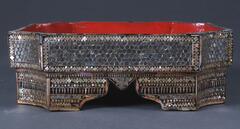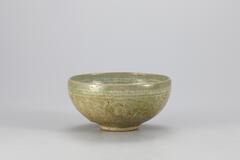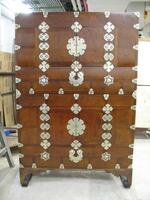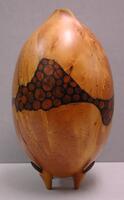18 UMMA Objects
18 UMMA Objects

Thai
Mother-of-pearl inlayed lacquer tray with geometric designs
19th century
Gift of Doris Duke's Southeast Asian Art Collection
2005/1.468

Korean (Korean (culture or style))
Wine cup with inlaid design of cranes flying among clouds
14th century
Gift of Bruce and Inta Hasenkamp and Museum purchase made possible by Elder and Mrs. Sang-Yong Nam
2004/1.247
![<p>This cup is similar in appearance to a round pot, with its mouth curving inwards slightly. The glaze has been oxidized, producing brown tints. The outer rim is black inlaid with a fret-patterned band, below which is also inlaid in black with chrysanthemum spray designs in three places. Coarse sand is stuck on the entire foot and outer base. Glaze has owed down to the interior of the cup during ring and has severely peeled off from the mouth and the outer surface in parts, exposing the body.<br />
[<em>Korean Collection, University of Michigan Museum of Art</em> (2014) p.123]<br />
</p>
<p>This cup is similar in appearance to a round pot, with its mouth curving inwards slightly. The glaze has been oxidized, producing brown tints. The outer rim is black inlaid with a fret-patterned band, below which is also inlaid in black with chrysanthemum spray designs in three places. Coarse sand is stuck on the entire foot and outer base. Glaze has owed down to the interior of the cup during ring and has severely peeled off from the mouth and the outer surface in parts, exposing the body.<br />
[<em>Korean Collection, University of Michigan Museum of Art</em> (2014) p.123]<br />
</p>](/media/W1siZiIsIjIwMjIvMDkvMjQvOG9sZTg1M2QydV9kZWZhdWx0LmpwZyJdLFsicCIsInRodW1iIiwiMjQweDIwMCJdXQ?sha=459b8b86f161841d)
Korean (Korean (culture or style))
Small Cup
1200 – 1399
Gift of Bruce and Inta Hasenkamp and Museum purchase made possible by Elder and Mrs. Sang-Yong Nam
2004/1.251
![This mirror box is decorated with lacquer and mother-of-pearl inlaid designs. Thelid of the box opens upwards, and has brass hinges and a closure in the sahpe of a flower. The lower drawer has a handle in the shape of a bat.<br />
<br />
This box has a mirror attached to the inside of its lid and was used by women. The box is decorated with hexagon and bamboo motifs by employing <em>kkeuneumjil</em> and <em>jureumjil</em> techniques. Hinges made of nickel are decorated with chiseled peonies on a ringmat ground. The corner brackets, or side wrappers, are in “I” shape. The single drawer has a handle in the shape of a bat, realistic to the extent of depicting antenna. Lacquer was heavily repainted on the base of the drawer. The frame of the mirror inside was decorated with fret-patterned band on left and right sides, and saw-tooth design on upper and lower sides.
<p>[Korean Collection, University of Michigan Museum of Art (2017) p. 266]</p>
This mirror box is decorated with lacquer and mother-of-pearl inlaid designs. Thelid of the box opens upwards, and has brass hinges and a closure in the sahpe of a flower. The lower drawer has a handle in the shape of a bat.<br />
<br />
This box has a mirror attached to the inside of its lid and was used by women. The box is decorated with hexagon and bamboo motifs by employing <em>kkeuneumjil</em> and <em>jureumjil</em> techniques. Hinges made of nickel are decorated with chiseled peonies on a ringmat ground. The corner brackets, or side wrappers, are in “I” shape. The single drawer has a handle in the shape of a bat, realistic to the extent of depicting antenna. Lacquer was heavily repainted on the base of the drawer. The frame of the mirror inside was decorated with fret-patterned band on left and right sides, and saw-tooth design on upper and lower sides.
<p>[Korean Collection, University of Michigan Museum of Art (2017) p. 266]</p>](/media/W1siZiIsIjIwMjIvMDkvMjQvMXJ3cjZhb282Z19kZWZhdWx0LmpwZyJdLFsicCIsInRodW1iIiwiMjQweDIwMCJdXQ?sha=808892293221e0e4)
Korean (Korean (culture or style))
Mirror Box
19th century
Gift of Ellen and Richard Laing
2006/2.61
![The cup rest is decorated with a lotus medallion with two rows of petals and its edge and foot are also shaped like a flower.The surface is coated with a greenish blue glaze. The edge and foot of the cup stand are decorated with white inlaid chrysanthemum motifs.
<p>This is a cup stand used during ceremonies or rituals. The tray is white inlaid with lines and dots, and on each lobe of the tray is incised a pair of chrysanthemum florets inlaid with white and black slip. The pedestal for cup on the stand has the wall carved with inverted lotus petals with bland and white slip. The glaze is applied thickly and is partially oxidized, producing a green-brown hue.<br />
[<em>Korean Collection, University of Michigan Museum of Art </em>(2014) p. 127]</p>
The cup rest is decorated with a lotus medallion with two rows of petals and its edge and foot are also shaped like a flower.The surface is coated with a greenish blue glaze. The edge and foot of the cup stand are decorated with white inlaid chrysanthemum motifs.
<p>This is a cup stand used during ceremonies or rituals. The tray is white inlaid with lines and dots, and on each lobe of the tray is incised a pair of chrysanthemum florets inlaid with white and black slip. The pedestal for cup on the stand has the wall carved with inverted lotus petals with bland and white slip. The glaze is applied thickly and is partially oxidized, producing a green-brown hue.<br />
[<em>Korean Collection, University of Michigan Museum of Art </em>(2014) p. 127]</p>](/media/W1siZiIsIjIwMjIvMDUvMjUvM2V2c3pncTJwZ19kZWZhdWx0LmpwZyJdLFsicCIsInRodW1iIiwiMjQweDIwMCJdXQ?sha=7d92c3ec5609280a)
Korean (Korean (culture or style))
Cup stand with molded and inlaid slip designs
13th century
Gift of Mrs. Caroline I. Plumer for the James Marshall Plumer Collection
1973/2.32
![The vase has a slightly outward-turned rim and a short neck. The elegantly-shaped bottle flares out to a broad shoulder, then tapers gradually to a slim waist before flaring out once more at the base. The shoulder, mid-belly and base of the vase are decorated with black and white clay-inlaid cloud, crane and butterfly motifs.
<p>The body of this vase is inlaid with clouds with black slip and butterflies inlaid with black and white slips, while the lower body is decorated with incised fret-patterned band. The mouth has been completely destroyed and repaired once, but has now fallen into decay. The glaze at the foot is opaque and cracked because of the low ring temperature and it has many pinholes on one side. Glaze was wiped away from the base, and there remain refractory spur marks.<br />
[<em>Korean Collection, University of Michigan Museum of Art</em> (2014) p.137]</p>
The vase has a slightly outward-turned rim and a short neck. The elegantly-shaped bottle flares out to a broad shoulder, then tapers gradually to a slim waist before flaring out once more at the base. The shoulder, mid-belly and base of the vase are decorated with black and white clay-inlaid cloud, crane and butterfly motifs.
<p>The body of this vase is inlaid with clouds with black slip and butterflies inlaid with black and white slips, while the lower body is decorated with incised fret-patterned band. The mouth has been completely destroyed and repaired once, but has now fallen into decay. The glaze at the foot is opaque and cracked because of the low ring temperature and it has many pinholes on one side. Glaze was wiped away from the base, and there remain refractory spur marks.<br />
[<em>Korean Collection, University of Michigan Museum of Art</em> (2014) p.137]</p>](/media/W1siZiIsIjIwMjIvMDUvMjUvZWRiaGFnd2pvX2RlZmF1bHQuanBnIl0sWyJwIiwidGh1bWIiLCIyNDB4MjAwIl1d?sha=311f4bfb4608e381)
Korean (Korean (culture or style))
Maebyeong (wine storage jar) with design cranes, butterflies, & stylized clouds
12th century
Transfer from the College of Architecture and Design
1972/2.80
![Inlaying silver into ironware was a popular method of decorating metalwork that required high levels of skill. Numerous items were produced with inlay decorations. The entire lid and body of this hexagonal case are decorated with inlaid silver. The lid features a hexagonal design in its center surrounded by a continuous four-leaf flower design. The six sides of the body are decorated by three pairs of turtle designs, crane designs and deer designs, arranged alternately. The lid and body are bordered with a fret-patterned band. This case with a flat base is excellently preserved. This type of iron-lidded case with inlaid silver design was produced in large quantities from the nineteenth century to the early twentieth century, continuing through the Japanese annexation of the Korean Peninsula. Such cases are mostly octagonal; this is a rare hexagonal example.
<p>[Korean Collection, University of Michigan Museum of Art (2017), 244]</p>
Inlaying silver into ironware was a popular method of decorating metalwork that required high levels of skill. Numerous items were produced with inlay decorations. The entire lid and body of this hexagonal case are decorated with inlaid silver. The lid features a hexagonal design in its center surrounded by a continuous four-leaf flower design. The six sides of the body are decorated by three pairs of turtle designs, crane designs and deer designs, arranged alternately. The lid and body are bordered with a fret-patterned band. This case with a flat base is excellently preserved. This type of iron-lidded case with inlaid silver design was produced in large quantities from the nineteenth century to the early twentieth century, continuing through the Japanese annexation of the Korean Peninsula. Such cases are mostly octagonal; this is a rare hexagonal example.
<p>[Korean Collection, University of Michigan Museum of Art (2017), 244]</p>](/media/W1siZiIsIjIwMjIvMDkvMjQvOThqa2s3NjF5M19kZWZhdWx0LmpwZyJdLFsicCIsInRodW1iIiwiMjQweDIwMCJdXQ?sha=8a82c3ce8eccee83)
Korean (Korean (culture or style))
Hexagonal Tobacco Box with Lid
1850 – 1950
Gift of Bruce and Inta Hasenkamp and Museum purchase made possible by Elder and Mrs. Sang-Yong Nam
2004/1.280A&B

Korean (Korean (culture or style))
Chest (in three pieces)
1850 – 1950
Museum Purchase made possible by the Margaret Watson Parker Art Collection Fund
2009/2.26A-C
![<p>This bowl was produced between the late 12th and 13th century, when ornate decoration was accorded greater importance than the beauty of color. A small circle was incised at the inner bottom, surrounded by two concentric circles inlaid with white slip. On the inner wall are decorated four small medallions inside which are rendered chrysanthemum sprays. On both the upper part of the inner and outer walls are decorated a band of scrolls and a pair of horizontal lines, respectively. The low foot displays refractory spur marks. Glaze drips and cracks are visible in parts of the bowl’s surface.<br />
[<em>Korean Collection, University of Michigan Museum of Art</em> (2014) p.104]</p>
<p>This bowl was produced between the late 12th and 13th century, when ornate decoration was accorded greater importance than the beauty of color. A small circle was incised at the inner bottom, surrounded by two concentric circles inlaid with white slip. On the inner wall are decorated four small medallions inside which are rendered chrysanthemum sprays. On both the upper part of the inner and outer walls are decorated a band of scrolls and a pair of horizontal lines, respectively. The low foot displays refractory spur marks. Glaze drips and cracks are visible in parts of the bowl’s surface.<br />
[<em>Korean Collection, University of Michigan Museum of Art</em> (2014) p.104]</p>](/media/W1siZiIsIjIwMjIvMDkvMjQvNjk3YnprbTBpZ19kZWZhdWx0LmpwZyJdLFsicCIsInRodW1iIiwiMjQweDIwMCJdXQ?sha=d4cfc0a923163d52)
Korean (Korean (culture or style))
Shallow bowl with inlaid chrysanthemum roundels, black and white slip
1150 – 1199
Gift of Bruce and Inta Hasenkamp and Museum purchase made possible by Elder and Mrs. Sang-Yong Nam
2004/1.241
![<p>This bowl is a fine example which displays the excellent decorative techniques applied to Goryeo celadon by its magnificent decorations: a band of foliage design right below the mouth, the four pomegranate designs on the inner wall, and a chrysanthemum floret on the inner bottom. On the outer surface, there are four sets of double concentric circles inlaid with white slip, each containing a chrysanthemum spray inlaid in black and white. The foot retains three quartzite spur marks. ere are cracks on the outer base due to the thickness of the wall. Glaze has been applied down to the foot and well-fused, while color is also evenly distributed.<br />
[<em>Korean Collection, University of Michigan Museum of Art </em>(2014) p.106]</p>
<br />
Shallow bowl with celadon glaze. Four concentric circles grace the exterior of the bowl, with a chrysanthemum roundel centered in the inner circle. Above these designs, three thinly incised bands stretch across the bowl parallel to the rim. In this location on the inside <p>This bowl is a fine example which displays the excellent decorative techniques applied to Goryeo celadon by its magnificent decorations: a band of foliage design right below the mouth, the four pomegranate designs on the inner wall, and a chrysanthemum floret on the inner bottom. On the outer surface, there are four sets of double concentric circles inlaid with white slip, each containing a chrysanthemum spray inlaid in black and white. The foot retains three quartzite spur marks. ere are cracks on the outer base due to the thickness of the wall. Glaze has been applied down to the foot and well-fused, while color is also evenly distributed.<br />
[<em>Korean Collection, University of Michigan Museum of Art </em>(2014) p.106]</p>
<br />
Shallow bowl with celadon glaze. Four concentric circles grace the exterior of the bowl, with a chrysanthemum roundel centered in the inner circle. Above these designs, three thinly incised bands stretch across the bowl parallel to the rim. In this location on the inside](/media/W1siZiIsIjIwMjIvMDkvMjQvNDQ4NThzczNxaV9kZWZhdWx0LmpwZyJdLFsicCIsInRodW1iIiwiMjQweDIwMCJdXQ?sha=ffafed5bb5c41c31)
Korean (Korean (culture or style))
Shallow Bowl with Litchi and Chrysanthemum Design
14th century
Gift of Bruce and Inta Hasenkamp and Museum purchase made possible by Elder and Mrs. Sang-Yong Nam
2004/1.244
![<p>This vessel was produced in a form typical of 13th century celadon bottles with the beautifully curved form and inlaid decorations on the entire surface. The body is divided into six segments, each of which is inlaid with chrysanthemum stems rst then stamped with owers using the inhwa (stamping) technique. Glaze was wiped away from the base and sand supports were used during ring. Glaze on the lower part of the bottle was poorly fused, yielding an opaque surface, however the overall quality of sintering is fine. The mouth has been repaired and restored. This piece is assumed to have been produced at a kiln at Yucheon-ri, Buan-gun, Jeollabuk-do.<br />
[<em>Korean Collection, University of Michigan Museum of Art</em> (2014) p.136]</p>
<p>This vessel was produced in a form typical of 13th century celadon bottles with the beautifully curved form and inlaid decorations on the entire surface. The body is divided into six segments, each of which is inlaid with chrysanthemum stems rst then stamped with owers using the inhwa (stamping) technique. Glaze was wiped away from the base and sand supports were used during ring. Glaze on the lower part of the bottle was poorly fused, yielding an opaque surface, however the overall quality of sintering is fine. The mouth has been repaired and restored. This piece is assumed to have been produced at a kiln at Yucheon-ri, Buan-gun, Jeollabuk-do.<br />
[<em>Korean Collection, University of Michigan Museum of Art</em> (2014) p.136]</p>](/media/W1siZiIsIjIwMjIvMDkvMjQvOTlvajVlZGNtbl9kZWZhdWx0LmpwZyJdLFsicCIsInRodW1iIiwiMjQweDIwMCJdXQ?sha=15576c14322f15fc)
Korean (Korean (culture or style))
Bottle with inlaid design of strands of chrysanthemum blossoms
1250 – 1299
Gift of Bruce and Inta Hasenkamp and Museum purchase made possible by Elder and Mrs. Sang-Yong Nam
2004/1.246
Loading…

